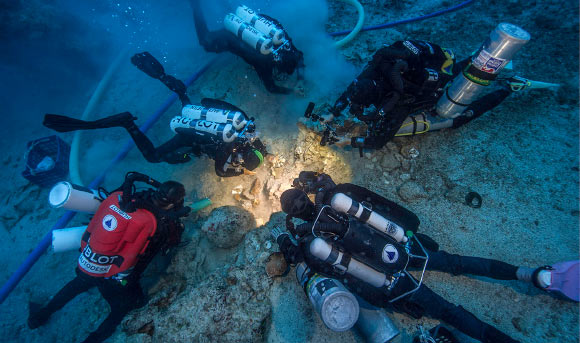An international group of archaeologists led by the Woods Hole Oceanographic Institution and the Hellenic Ministry of Culture and Sports has discovered a 2,050-year-old human skeleton during the excavation of the famous Antikythera shipwreck.

Archaeologists Brendan Foley, Theotokis Theodoulou and Alex Tourtas excavate the Antikythera shipwreck skeletal remains, assisted by Nikolas Giannoulakis and Gemma Smith. Image credit: Brett Seymour / EUA / WHOI / ARGO.
The Antikythera wreck is a Roman-era shipwreck dating from the first century BC (85-50 BC).
It is located on the east side of the Greek island of Antikythera near Crete at the crossroads of the Aegean and Mediterranean Seas.
The Antikythera ship is thought to have been carrying looted treasures from the coast of Asia Minor to Rome, to support a triumphal parade being planned for Julius Caesar.
The wreck was discovered in 1900 by a group of Greek sponge divers on their way to Tunisia who took shelter from a storm near the island and decided to look for sponges while they waited for calmer conditions.
Early excavations at the site revealed a wealth of discoveries that today are housed in the National Archaeological Museum in Athens, Greece. These included three life-size marble horses, jewelry, coins, glassware, and hundreds of works of art, including a 7-foot-tall statue of Herakles.
The most surprising discovery was the corroded remnants of a complex device known as Antikythera Mechanism, which is believed to be an early analog computer used to plan important events including religious rituals, the early Olympic Games, and agricultural activities. It was capable of predicting the movement of the Sun, Moon, and several planets, as well as the timing of solar and lunar eclipses years into the future.
In 1976, the famed French oceanographer Jacques-Yves Cousteau and his team returned to the wreck and recovered nearly 300 more objects, including skeletal remains of the passengers and crew.
The skeleton discovered three weeks ago is the first to be recovered from the shipwreck since the advent of DNA studies.
The archaeologists recovered a human skull including a jaw and teeth, long bones of the arms and legs, ribs, and other remains. Other portions of the skeleton are still embedded in the seafloor, awaiting excavation during the next phase of operations.
If enough viable DNA is preserved in the bones, it may be possible to identify the ethnicity and geographic origin of the shipwreck victim.
“Against all odds, the bones survived over 2,000 years at the bottom of the sea and they appear to be in fairly good condition, which is incredible,” said Dr. Hannes Schroeder, an expert in ancient DNA at the Natural History Museum of Denmark in Copenhagen.
“Archaeologists study the human past through the objects our ancestors created,” said Dr. Brendan Foley, a marine archaeologist with the Woods Hole Oceanographic Institution.
“With the Antikythera shipwreck, we can now connect directly with this person who sailed and died aboard the Antikythera ship.”







